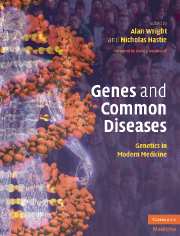Book contents
- Frontmatter
- Contents
- List of Contributors
- Foreword
- Section 1 Introductory Principles
- Section 2 Common Medical Disorders
- 13 Developmental disorders
- 14 Genes, environment and cancer
- 15 The polygenic basis of breast cancer
- 16 TP53: A master gene in normal and tumor suppression
- 17 Genetics of colorectal cancer
- 18 Genetics of autoimmune disease
- 19 Susceptibility to infectious diseases
- 20 Inflammatory bowel diseases
- 21 Genetic anemias
- 22 Genetics of chronic disease: obesity
- 23 Type 2 diabetes mellitus
- 24 Genetics of coronary heart disease
- 25 Genetics of hypertension
- 26 Obstructive pulmonary disease
- 27 Skeletal disorders
- 28 The genetics of common skin diseases
- 29 Molecular genetics of Alzheimer's disease and other adult-onset dementias
- 30 Major psychiatric disorders in adult life
- 31 Speech and language disorders
- 32 Common forms of visual handicap
- 33 Genetic and environmental influences on hearing impairment
- 34 Pharmacogenomics: clinical applications
- Index
- References
32 - Common forms of visual handicap
Published online by Cambridge University Press: 17 August 2009
- Frontmatter
- Contents
- List of Contributors
- Foreword
- Section 1 Introductory Principles
- Section 2 Common Medical Disorders
- 13 Developmental disorders
- 14 Genes, environment and cancer
- 15 The polygenic basis of breast cancer
- 16 TP53: A master gene in normal and tumor suppression
- 17 Genetics of colorectal cancer
- 18 Genetics of autoimmune disease
- 19 Susceptibility to infectious diseases
- 20 Inflammatory bowel diseases
- 21 Genetic anemias
- 22 Genetics of chronic disease: obesity
- 23 Type 2 diabetes mellitus
- 24 Genetics of coronary heart disease
- 25 Genetics of hypertension
- 26 Obstructive pulmonary disease
- 27 Skeletal disorders
- 28 The genetics of common skin diseases
- 29 Molecular genetics of Alzheimer's disease and other adult-onset dementias
- 30 Major psychiatric disorders in adult life
- 31 Speech and language disorders
- 32 Common forms of visual handicap
- 33 Genetic and environmental influences on hearing impairment
- 34 Pharmacogenomics: clinical applications
- Index
- References
Summary
Introduction
The evolution, comparative structure and function of the eye have attracted the attention of many scientists, including Isaac Newton, who first showed that light could be split into different wavelengths, and later Charles Darwin, for whom the eye presented an interesting test of the evolutionary paradigm. Newton laid the foundations for the trichromatic theory of vision (Young, 1802), whereby different wavelengths of light are perceived by three distinct receptors within the retina, with overlapping sensitivities, now known to be the short-, medium- and long-wavelength cone opsins. The eye interacts with the environment in the most direct way, since it is constantly bombarded with electromagnetic radiation of many wavelengths and yet it specifically responds only to those in the 400–700 nm range. These wavelengths correspond closely to the solar spectrum measured below the surface of the sea, where the earliest visual systems are thought to have evolved (McIlwaine, 1996). An otherwise rare member of the carotenoid family, 11-cis retinal, an isomer of vitamin A aldehyde, has the important property of changing shape on absorbing a photon of light. This molecule combines with the different opsin apoproteins, which are members of the G-protein coupled receptor superfamily, to form the visual photopigment in all multicellular animals. In this way, light serves to generate a neural signal but at the same time renders the eye vulnerable to oxidative damage, which is a major factor in at least two of the major causes of global blindness.
- Type
- Chapter
- Information
- Genes and Common DiseasesGenetics in Modern Medicine, pp. 488 - 504Publisher: Cambridge University PressPrint publication year: 2007



